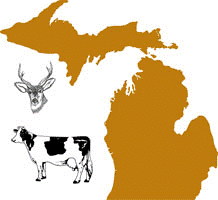Wildlife Disease and Zoonotics

Michigan Bovine Tuberculosis Bibliography and Database
Date of this Version
11-2004
Abstract
Objective—To investigate the infection of calves with Mycobacterium bovis through oral exposure and transmission of M bovis from experimentally infected white-tailed deer to uninfected cattle through indirect contact.
Animals—24 11-month-old, white-tailed deer and 28 6-month-old, crossbred calves.
Procedure—In the oral exposure experiment, doses of 4.3 X 106 CFUs (high dose) or 5 X 103 CFUs (low dose) of M bovis were each administered orally to 4 calves; as positive controls, 2 calves received M bovis (1.7 X 105 CFUs) via tonsillar instillation. Calves were euthanatized and examined 133 days after exposure. Deer-to-cattle transmission was assessed in 2 phases (involving 9 uninfected calves and 12 deer each); deer were inoculated with 4 X 105 CFUs (phase I) or 7 X 105 CFUs (phase II) of M Bovis. Calves and deer exchanged pens (phase I; 90 days’ duration) or calves received uneaten feed from deer pens (phase II; 140 days’ duration) daily. At completion, animals were euthanatized and tissues were collected for bacteriologic culture and histologic examination.
Results—In the low- and high-dose groups, 3 of 4 calves and 1 of 4 calves developed tuberculosis, respectively. In phases I and II, 9 of 9 calves and 4 of 9 calves developed tuberculosis, respectively.
Conclusions and Clinical Relevance—Results indicated that experimentally infected deer can transmit M bovis to cattle through sharing of feed. In areas where tuberculosis is endemic in free-ranging white-tailed deer, management practices to prevent access of wildlife to feed intended for livestock should be implemented.


Comments
Published in AJVR, Vol 65, No. 11, November 2004.